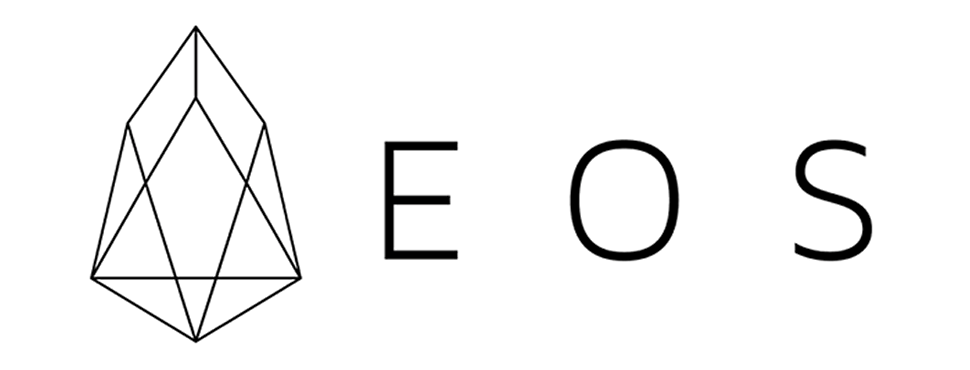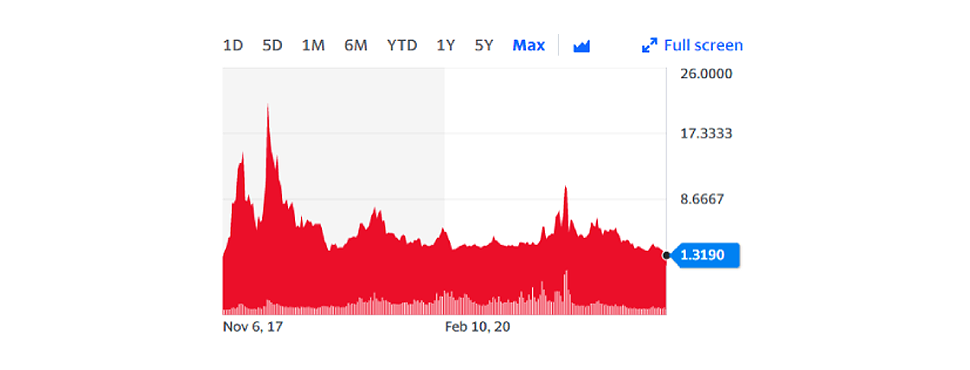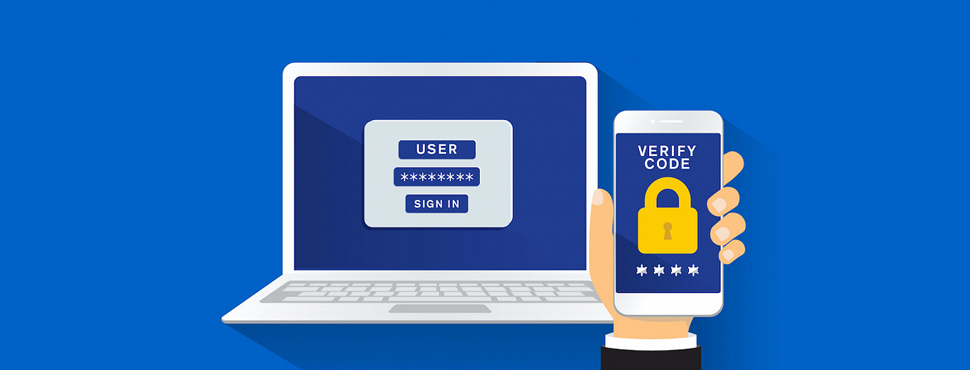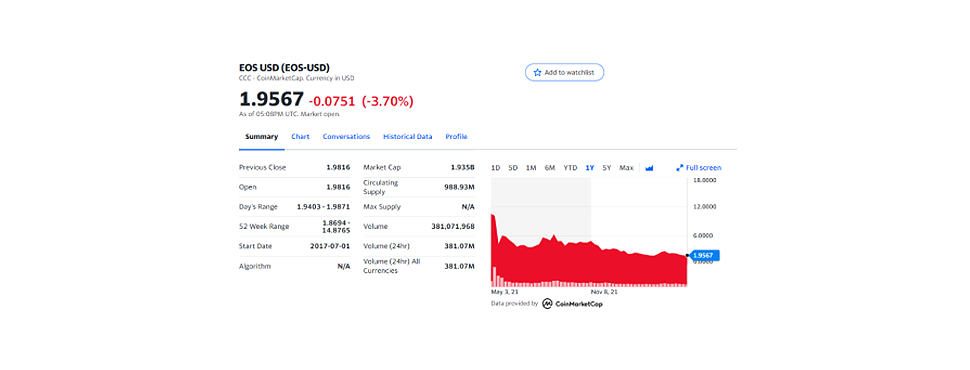share
If you are reading this article, you probably have heard about Bitcoin, other cryptocurrencies, and blockchain technology. Hundreds of projects are based on blockchain, and many of them have managed to get the same promotion as Bitcoin. Here is what our experts managed to find about one of the digital currencies – EOS tokens and how the network got promoted to today’s level.
Introduction to EOS

To make it more clear, we need to specify that EOS itself, like many other blockchain-based projects, isn’t a digital currency. EOS is a special platform where users can design distributed apps. If creators want to develop such applications, they need to buy EOS tokens and enter the platform, which provides them with all the capabilities to fund and develop their own projects within the EOS ecosystem.
The access is provided only to those users who own EOS coins previously bought during open trades. As of the time of writing this review, the EOS price was closing at 1.9816 USD per token. If you want to develop dApps, learn the updated EOS price before buying it.
The History of Project Development and Promotion
The history of this blockchain platform dates back to 2017. The creator of the project is a company called Block.one works on other blockchain projects as well, but EOS is the most successful one. Its aim is to make the development process of decentralized apps as easy and secure as possible.
The Key Promotional Features of the EOS Project
The white paper for the EOS project was published in 2017. The founders that they would launch a network that would help any development team forget about when creating decentralized applications on blockchains. They promised to create a crypto asset that would execute enormous amounts of transactions in the shortest possible terms. In addition, Block.one stated that the project would also be capable of solving a lot of issues related to the validation speed.
How the Promotion of the Project Was Started
Actually, the promotion of the EOS project started long before its launch. The team behind the project worked well to set the bar of expectations very high and attract as many investors as possible.
The promotion of this network started with the introduction of the ERC-20 token. Users could buy and operate them via the Ethereum blockchain. The Block.one team announced that these tokens would be converted to the EOS tokens as soon as the independent blockchain network is launched. This was supposed to happen at the beginning of June 2018. Until that time, the team behind the project was running the yearly Initial Coin Offering.
The holders of the token, which was supposed to become a native token for the upcoming platform, were warned to register their holdings before the date of the network launch. Those holders who did not register the assets lost them.
Was the Promotion Effective?
It is a curious question to answer because the success of the quality of the promotion of the project might be estimated by several factors. The first one is the amount of money raised during the Initial Coin Offering. In the case of Block.one, the total amount of raised money exceeded the mark of $4 billion, which was an absolute record on the market.
The second aspect that shows how well the promotion was is the value of the native tokens. A year before the project was launched to the market. The EOS tokens were traded at $4.33 even without having a native network. At the end of 2017, which was around 6 months before the project release, the value of the token blasted through the mark of $10 for the first time in its history. Even though the project wasn’t launched yet, its coin appeared to be the best performing crypto asset as of the beginning of 2018. It was the time when prices of many coins were going down, but the EOS token managed to reach its record value of $22.89.

Last but not least thing to consider when estimating the effectiveness of the promotion is the hype around the project. In 2017 and 2018, EOS was warmly discussed with the wide publicity. The prospects of the project were even discussed in one of the episodes of the “Last Week Tonight” talk show hosted by John Oliver, which has 18 million views on YouTube as of the date of writing.

EOS Features That Make the Project Promotion Easier
Actually, there are a lot of blockchain projects that offer features similar to EOS. However, EOS has gained popularity because it’s focused specifically on dApps development. In addition to this, this platform introduces some extraordinary features. Here are a few of them.
Scalability
Any blockchain platform depends on networking, which is often a problem because such an architecture cannot become mainstream and reach the mass market. Therefore, many blockchain-based applications are often limited in terms of available resources.

EOS solves this issue by introducing scalability solutions. Such features as asynchronous access to resources and parallel execution provide many developers with the possibility to access the platform and use its capacities at the same time, without any software bugs.
Free Access Model
The majority of blockchain platforms that provide new users with the same possibilities operate under the transactional model. This means that users can work with the network only if they consume certain tokens provided by a specific platform. EOS works differently.
Well, this model is not completely free because you still have to buy tokens that depend on the EOS price. However, with EOS, you aren’t required to consume them – the access is provided to the holders of EOS tokens. This means the users pay only once – when they buy tokens. Then, they can develop things on this network just for holding coins.
Tools for Developers
If developers aim to create sophisticated and efficient apps that can solve multiple issues and perform multiple operations, they choose EOS. The thing is that the development kit of this platform is extremely extensive. Although it contains a lot of complicated tools, these instruments are capable of solving the most complex problems. Block.One, actually, did a great job in terms of the development kit because it is what makes EOS stand out from the crowd of the competitors.
Authentication
The main objective of EOS is to make creating new apps quicker and easier. One more feature committed to this goal is specific authentication. EOS provides developers with the possibility to sign up new accounts on the blockchain database. It also helps the network itself to become more efficient. When one task, such as user authentication, is repeated very often, it becomes a part of the network’s architecture.

Proof-Of-Stake Model
Initially, blockchain networks were developed on the proof-of-work model. This mechanism requires a lot of power to process transactions. Therefore, it consumes a lot of energy. The proof-of-work model is commonly used by different blockchain networks because it’s a proven and secure mechanism.

Proof-of-stake is a younger but more efficient model. This mechanism has better scalability than proof-of-work. Plus, the network of computers that make up the EOS blockchain is organized according to how many tokens each participant owns. The more tokens someone holds, the greater a role they play in storing and resolving data on the EOS network.
What Impacts EOS Price
The structure of the platform impacts the EOS price and the value of tokens. The unique features of the network make it a full-package platform. Moreover, users can become equal participants in the network and vote for different decisions. Such a feature is very valued in the crypto world, and it highly contributes to the EOS value.

Conclusion: What Are the Advantages of EOS That Make It So Popular?

- It’s underrated. Although EOS is considered to be one of the best platforms for dApps developers, it’s still undervalued.
- It’s accessible. EOS tokens are listed on major crypto exchanges such eToro, Coinbase, Binance, and others. This proves its legitimacy. Plus, the affordable EOS price makes it easy to buy a large number of tokens.
- It’s free to use. Great scalability and free usage will attract more developers to the platform. The more developers will use it, the more advantages the network will have in the long run.
- It has low latency. Many distributed apps developed on other platforms aren’t usable because they might not respond for a long time. The low latency of EOS prevents this issue and makes EOS a great choice for investors.









